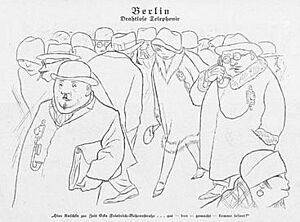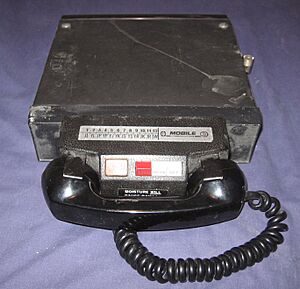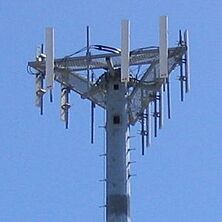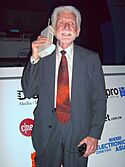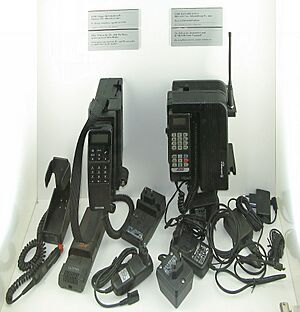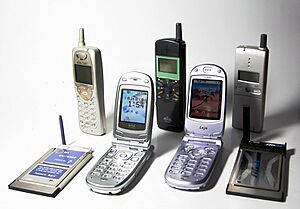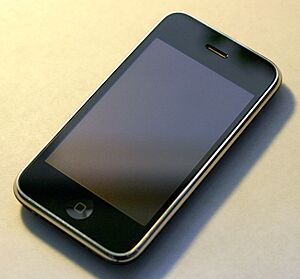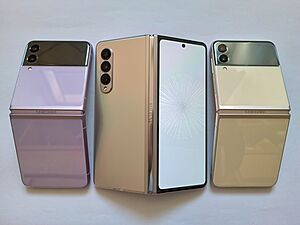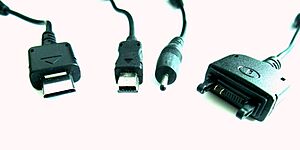History of mobile phones facts for kids
The history of mobile phones tells the story of how mobile communication devices came to be. These devices connect wirelessly to the regular phone network.
Long ago, people found ways to send speech using signals. But the first devices that were truly wireless, mobile, and could connect to the standard phone network are much more recent. These early devices were very big and hard to carry compared to today's small phones. Using them was also a bit clumsy.
Today, huge changes have happened in wireless communication. Smartphones are now common everywhere. More and more people are using mobile broadband to get online.
Contents
Early Ideas and Inventions
First Steps in Wireless Phones
Back in 1908, a professor named Albert Jahn and his company claimed they made a wireless phone. Later, in 1917, a Finnish inventor named Eric Tigerstedt got a patent for a "pocket-size folding telephone."
Starting in 1918, the German railroad system tested wireless phones on military trains. By 1924, public tests began for phone calls on trains between Berlin and Hamburg. Soon after, in 1926, phone service was approved for first-class travelers on trains between Hamburg and Berlin.
Even before real mobile phones existed, artists imagined them! In 1906, a cartoonist showed people using wireless devices in London's Hyde Park. In 1926, the artist Karl Arnold drew a cartoon about people using mobile phones on the street. The famous detective Dick Tracy even had a two-way wrist radio in 1946.
During World War II (1939-1945), the military used radio phones. Hand-held radios have been around since the 1940s. Mobile phones for cars also became available from some phone companies in the 1940s. These early devices were big and used a lot of power. Only a few people could talk at the same time.
In the United States, engineers at Bell Labs started working on a system for mobile calls from cars. This service began on June 17, 1946, in St. Louis, Missouri. Early mobile phone services had limited coverage. Calls were sent as unencrypted signals, meaning anyone with radio equipment could listen in.
In 1957, a Soviet engineer named Leonid Kupriyanovich created some experimental pocket-sized radios. One model from 1961 weighed only 70 grams and could fit in a hand.
In 1965, a Bulgarian company showed a mobile automatic phone with a base station. One base station could serve up to 15 users.
Mobile phone technology has grown through different "generations." These started with "0G" services, then came first-generation (1G) analog networks in 1979. Second-generation (2G) digital networks arrived in 1991, followed by third-generation (3G) internet services in 2001. Fourth-generation (4G) networks launched in 2006, and 5G began in 2019.
Early Mobile Phone Services
Mobile Telephone Service (MTS)
In 1949, AT&T launched its Mobile Telephone Service (MTS). By 1948, it was available in 100 towns. MTS was rare, with only 5,000 customers making about 30,000 calls each week. Operators had to connect calls manually. Users had to press a button to speak and release it to listen. The phone equipment weighed about 80 pounds (36 kg)!
This technology had many limits. Only three people in a city could make mobile calls at once. MTS was also very expensive.
In the UK, a car-based system called "Post Office Radiophone Service" started in 1959. It also needed an operator but allowed calls to any phone in Great Britain.
Improved Mobile Telephone Service (IMTS)
In 1965, AT&T improved its mobile phone service, calling it Improved Mobile Telephone Service (IMTS). IMTS used more radio channels, allowing more calls at once. Customers could dial calls themselves, without an operator. The equipment also became smaller and lighter.
Even with these improvements, demand was still higher than the system's capacity. In New York City, 2,000 customers shared just 12 radio channels. They often had to wait 30 minutes to make a call.
Radio Common Carrier (RCC)
Radio Common Carrier (RCC) services started in the 1960s. These were offered by smaller phone companies to compete with AT&T's IMTS. RCC systems used different radio frequencies. They were used until the 1980s when newer cellular systems made them outdated.
Some RCC systems allowed users from nearby areas to use their service. However, phones from one RCC system might not work in another city because the technical standards were not the same. Modern "roaming" (using your phone in different areas) was not really possible.
Other Early Services
In 1969, the Penn Central Railroad added special pay phones to commuter trains. Passengers could make calls while the train was moving.
In the UK, a system called "Rabbit" was briefly used. It was a mix of base stations and handsets. A big problem was that you had to be very close (less than 300 feet) to a base station for it to work.
European Mobile Radio Networks
In Europe, several different mobile radio services were developed. They often didn't work with each other.
Norway had a system called OLT in 1966. Finland's ARP launched in 1971. Both were controlled manually. These were later replaced by the automatic NMT system in the early 1980s.
West Germany had a network called A-Netz starting in 1952. In 1972, it was replaced by B-Netz, which connected calls automatically.
The Cellular Idea
In 1947, Bell Labs engineers Douglas H. Ring and W. Rae Young suggested using hexagonal cells for mobile phones in cars. At that time, the technology to make this happen didn't exist, and no radio frequencies were set aside for it.
Twenty years later, other Bell Labs engineers, Richard H. Frenkiel, Joel S. Engel, and Philip T. Porter, developed these ideas further. Porter suggested that cell towers use special antennas to reduce interference and allow frequencies to be reused more often. He also invented the "dial-then-send" method, which all cell phones use today to save channel time.
In these early systems, a mobile phone had to stay within the area of one base station during a call. If you moved to another area, your call would drop. The ideas of reusing frequencies and "handoff" (passing a call from one cell to another) were developed in the late 1960s. In 1970, Amos E. Joel, Jr. invented a circuit to help with call handoffs.
Automated Mobile Services Appear
The first fully automated mobile phone system for vehicles started in Sweden in 1956. It was called MTA. You could make and receive calls in the car using a rotary dial. Calls from the car were direct dial. For incoming calls, an operator found the closest base station to the car. MTA phones were very heavy, weighing 40 kg (88 lbs)!
In 1962, an improved version called MTB was released. It had push-buttons and used transistors for better reliability. In 1971, the MTD version launched, which became a commercial success. This network stayed open until 1983.
In 1958, work began on a similar system in the USSR called "Altay." This service started in Moscow in 1963 and was in 30 cities by 1970.
In 1966, Bulgaria showed a small, automatic mobile phone called RAT-0,5 with a base station. One base station could serve up to six customers.
One of the first successful public mobile phone networks was the ARP network in Finland, launched in 1971. Some people see ARP as a "zero generation" (0G) cellular network.
The Handheld Mobile Phone Arrives
Before 1973, mobile phones were only found in cars and other vehicles. The first portable cellular phone for a cellular network was developed by E.F. Johnson and Millicom. It was introduced in Sweden in 1981.
Motorola was the first company to make a handheld mobile phone. On April 3, 1973, Martin Cooper, a Motorola researcher, made the first mobile phone call from a handheld device. He called his rival, Dr. Joel S. Engel at Bell Labs. The prototype phone Cooper used weighed 2 kg (4.4 lbs) and was quite large. It only offered 30 minutes of talk time and took 10 hours to recharge! This phone, often called "the Brick," was not sold to the public until October 1983 in the U.S.
John F. Mitchell, Cooper's boss at Motorola, was key in pushing for smaller, portable wireless devices.
Mobile Phone Generations
Newer mobile phone technology has come out in "generations." The term "generation" became popular when 3G was launched.
1G – Analog Cellular
The first automatic analog cellular systems were launched in Japan by NTT in 1979 for car phones. Comvik in Sweden and NMT in other Nordic countries followed in 1981.
In North America, the Advanced Mobile Phone System (AMPS) was widely used. It launched in 1983. AMPS helped make cellular technology popular. However, it had problems: calls were not encrypted and could be easily listened to. It also used a lot of radio space.
On March 6, 1983, the DynaTAC 8000X mobile phone launched on the first US 1G network. It cost $100 million to develop. The phone had only 30 minutes of talk time and took 10 hours to charge. Even with these limits, many people wanted one, and there were thousands on waiting lists.
Many early cell phones, like the Motorola DynaTAC, were later replaced by digital versions. Most North American carriers shut down AMPS service by 2008.
2G – Digital Cellular
In the 1990s, "second generation" (2G) mobile phone systems appeared. Two main systems competed: the European GSM standard and the U.S. CDMA standard. These systems used digital signals instead of analog. This led to a huge increase in mobile phone use. This era also saw the start of prepaid mobile phones.
In 1991, the first GSM network launched in Finland. 2G systems used higher frequencies in Europe than in the United States. Older 1G systems were quickly shut down to make room for 2G.
In 1993, the IBM Simon was introduced. This was possibly the world's first smartphone. It was a phone, pager, fax machine, and PDA all in one! It had a calendar, address book, clock, calculator, notepad, email, and a touchscreen with a QWERTY keyboard. It even had a stylus and could guess the next characters as you typed.
With 2G, phones became much smaller, often weighing only 100-200 grams. This was possible because of better batteries and more energy-efficient electronics. Also, there were more cell towers, so phones didn't have to send signals as far, which saved battery life.
The second generation also brought SMS or text messaging. The first text message was sent in the UK in 1992. In 1993, the first person-to-person SMS was sent in Finland. With prepaid services in the late 1990s, texting quickly became popular, especially among young people.
2G also allowed access to media content on phones. In 1998, the first downloadable content sold was the ringtone. Advertising on mobile phones started in Finland in 2000 with a free daily SMS news service.
Mobile payments were tested in 1998 in Finland and Sweden. People used phones to pay for a Coca-Cola machine and parking. Commercial mobile payment systems launched in 1999 in Norway and the Philippines.
The first full internet service on mobile phones was introduced in Japan in 1999.
3G – Mobile Broadband
As 2G phones became very common, people wanted more data, like browsing the internet. Fixed internet services showed that people would always want faster data speeds. 2G technology wasn't fast enough, so the industry started working on 3G. The main difference was that 3G used packet switching for data, which is more efficient than the older circuit switching.
Many different 3G standards appeared, making a single worldwide standard difficult. Some 2G networks became 3G-compatible with updates.
The first test 3G network launched in Japan in May 2001. NTT DoCoMo launched the first commercial 3G network in October 2001. By the end of 2002, other 3G networks launched in South Korea and Japan. European 3G launches happened in Italy and the UK.
During the development of 3G, "2.5G" systems like GPRS were created as upgrades to 2G networks. These offered some 3G features but not the full high speeds.
The fast speeds of 3G changed the industry. For the first time, people could stream radio and even TV content to their phones.
In the mid-2000s, an improved 3G technology called HSDPA (High-Speed Downlink Packet Access) was introduced. It was also called 3.5G or turbo 3G. It allowed much faster data transfer speeds, up to 14.0 Mbit/s.
By the end of 2007, there were 295 million 3G users worldwide. 3G services made over $120 billion in revenue in 2007. In some countries, like Japan and South Korea, only 3G phones were sold.
While phones could access the internet before, it wasn't until good 3G coverage became widespread that special devices for mobile internet appeared. The first were "dongles" that plugged into computers. Later, "compact wireless routers" like the MiFi allowed multiple computers to connect to 3G internet over Wi-Fi.
These devices became popular for laptops. Some laptop makers started building mobile data directly into laptops, so you just needed a SIM card. These were called "netbooks." Other devices like e-readers (Amazon Kindle) and tablets (Apple iPad) also started to include built-in wireless internet.
4G – Native IP Networks
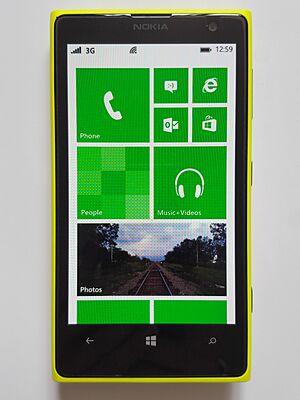
By 2009, it was clear that 3G networks would soon be overloaded by apps that used a lot of data, like streaming media. So, the industry started looking at "fourth-generation" (4G) technologies. These promised speeds up to ten times faster than 3G. The first public LTE service launched in Scandinavia in 2009. In the 2010s, 4G technology found many uses, including mobile internet, internet of things (IoT), and streaming music and video.
One big difference with 4G was that it used an "all-IP network." This meant that voice calls were treated like any other streaming audio, using packet switching over the mobile network via VoLTE.
5G – Cellular Mobile Communications
The rollout of "fifth-generation" (5G) cellular networks began worldwide in 2019. 5G is defined by the 5G NR (5G New Radio) standard. 5G can use different radio bands, offering download speeds that can reach gigabits per second. It aims for very low network delay (1 millisecond). This fast response time and better data performance are important for things like online gaming, augmented and virtual reality, autonomous vehicles, and critical communication services.
Satellite Phones
A satellite phone is a type of mobile phone that connects to other phones or the regular phone network using satellites orbiting the Earth. Unlike regular cellphones that use local cell towers, satellite phones can work in most places on Earth, as long as they have a clear view of the sky and the satellite.
The benefit of a satellite phone is that it can be used in areas where there are no local phone towers, like remote regions. Satellite phones are also very reliable during natural disasters or wars, when local communication systems might be damaged.
The Inmarsat system is the oldest, created in 1979 for safety at sea. It uses satellites in geostationary orbit to cover most of the world. Other systems, like Iridium and Globalstar, use many low Earth orbit satellites closer to Earth.
Satellite Features in Regular Phones
In the early 2020s, phone makers started adding satellite connection features to regular smartphones. This allows them to work in remote areas outside of cell tower range. These satellite-to-phone services use special frequencies that work with most modern phones. However, because regular phone antennas are small, early satellite features are limited to sending text messages and emergency calls.
In 2022, the Apple iPhone 14 started allowing emergency text messages via satellites. In 2023, the Apple iPhone 15 added satellite communication for roadside assistance in the United States. Other companies like T-Mobile, AST SpaceMobile, and Qualcomm are also working on bringing satellite connectivity to regular smartphones.
Mobile Device Charger Standards
| Port | Current | Voltage | Power (max) |
|---|---|---|---|
| Micro-USB | 500 mA | 5 V | 2.5 W |
| 1 A | 5 V | 5 W | |
| 2 A | 5 V | 10 W | |
| USB-C | 100 mA to 3 A | 5 V | 15 W |
| 1.7 A to 3 A | 9 V | 27 W | |
| 1.8 A to 3 A | 15 V | 45 W | |
| 2.25 A to 5 A | 20 V | 100 W |
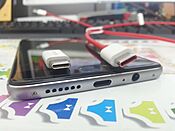
Before a common charger standard was agreed upon in the late 2000s, users needed a specific charger for each phone brand. Later, most major phone brands started using a USB cable with a micro-USB or, more recently, a USB-C port. Apple's iPhone was the only major brand to keep its own special connector (first a 30-pin connector, then Lightning). However, in 2023, Apple's iPhone 15 series finally switched to USB-C. Now, all major brands use USB-C for charging.
Universal Charging Solutions
In 2007, a group of mobile companies agreed on Micro-USB as the future common connector for mobile devices. In 2009, the GSM Association (GSMA) and the International Telecommunication Union (ITU) also supported this "one-charger-fits-all" solution. They noted that these chargers would be more energy-efficient.
EU Smartphone Charger Rules
In 2009, many big mobile phone makers signed an agreement with the EC. They agreed to make most phones sold in the European Union work with a common external power supply. This standard was based on USB charging.
In 2022, a new rule in the EU stated that all new smartphones must use USB-C as a universal charger by the end of 2024. Laptops will follow by 2026.
See also
 In Spanish: Historia del teléfono móvil para niños
In Spanish: Historia del teléfono móvil para niños
- Camera phone
- The Mobile Revolution
- History of prepaid mobile phones
- History of the telephone
- List of best-selling mobile phones
- Pager
- SIM card
- Smartphone § History


